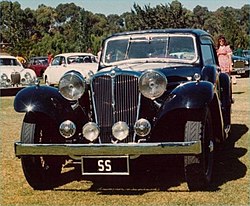SS1
| SS | |
|---|---|
|
SS1 Airline Saloon (1935)
|
|
| 1 | |
| Production period: | 1931-1936 |
| Class : | upper middle class |
| Body versions : | Touring car , roadster , sedan , coupé |
| Engines: |
Petrol engines : 2.05–2.7 liters (36–51 kW) |
| Length: | 4720-4750 mm |
| Width: | 1613-1664 mm |
| Height: | 1450 mm |
| Wheelbase : | 3020 mm |
| Empty weight : | 1043 kg |
| successor | Jaguar Mark IV |
The SS1 was the first car with an independent chassis on the production of sporty and elegant bodies for chassis from Austin , Wolseley and Standard specialized Swallow Coach Building Co. brought out. The standard Swallow 16 HP could be seen as an indirect predecessor, a sporty sedan model that was bodied by Swallow on the unchanged chassis of the Standard 16 HP "Ensign" and a few copies were produced in 1935.
The SS 1 came on the market in October 1931 as a two-door coupé, with a vinyl-covered fixed roof and functionless storm bars (actually a linkage for tensioning a convertible top) on the sides, which gave the false impression of a convertible ( faux convertible ). It had a six-cylinder in-line engine with 2054 cm³ displacement (16 HP, tax horsepower) and 45 bhp (34 kW) or 2552 cm³ displacement (20 HP) with around 55 bhp (41 kW). Both engines were delivered as standard including the fully assembled chassis. The rear wheels were driven via a four-speed gearbox with center shift. The top speed was 110 km / h.
After just one year, in autumn 1932, the SS 1 received a modified and larger body with which it could be viewed as a four-seater. The engines became slightly more powerful. From the beginning of 1933 the car was also offered as an open four-seater tourer and from autumn 1933 as a saloon with rear side windows instead of the chrome-plated storm pole imitations. At the same time, the stroke of both engine sizes was increased to the 106 mm used by Jaguar until 1992, resulting in 2143 and 2663 cm³ displacement. Because the cylinder bore remained the same, the “tax horsepower” did not change. The motorized car drove up to 125 km / h. In 1934 Charles Needham and Sydney Light won the “Concours de Confort” with an SS 1 at the Monte Carlo Rally .
A fashionable “Airline Saloon” was part of the program from autumn 1934 after the coupé was no longer officially offered, but nevertheless remained available on special request. From now on the engines had two carburettors as standard and an even higher compression ratio, so that the 20 HP engine reached almost 70 bhp (52 kW). At the beginning of 1935, the Drophead Coupé finally came out, which differed from the Tourer in having a lavishly constructed, lined hood that could be lowered into the trunk.
When the production of the SS 1 was stopped in July 1935, a total of 4,250 units had been produced. The SS 1s offered as vintage 1936 were unsold examples from model year 1935, which were provided with a larger radiator grille. The successor was the SS Jaguar 2 ½ liter Saloon.
swell
- Schrader, Halwart: Jaguar type compass - passenger cars since 1931, Motorbuch-Verlag, Stuttgart (2001), ISBN 3-613-02106-4
- Stertkamp, Heiner: Jaguar - the complete chronicle from 1922 to today, 2nd edition, Heel-Verlag, (2006) ISBN 3-89880-337-6
| Jaguar models timeline from 1945 to 1970 | ||||||||||||||||||||||||||
|---|---|---|---|---|---|---|---|---|---|---|---|---|---|---|---|---|---|---|---|---|---|---|---|---|---|---|
| Type \ vintage | Independently | BMH | British Leyland | |||||||||||||||||||||||
| 1940s | 1950s | 1960s | ||||||||||||||||||||||||
| 5 | 6th | 7th | 8th | 9 | 0 | 1 | 2 | 3 | 4th | 5 | 6th | 7th | 8th | 9 | 0 | 1 | 2 | 3 | 4th | 5 | 6th | 7th | 8th | 9 | 0 | |
| upper middle class | 2.4 Liter / 3.4 Liter (Mark I) | Mark 2 2.4 / 3.4 / 3.8 | 240/340 | |||||||||||||||||||||||
| 1 ½ liter | S-Type (3.4 S & 3.8 S) | |||||||||||||||||||||||||
| Upper class | 2 ½ liters | Mark V 2½ | 420 | XJ 6 (Series 1) ... | ||||||||||||||||||||||
| 3 ½ liter | Mark V 3½ | Mark VII | Mark VIII | Mark IX | Mark X | 420 G | ||||||||||||||||||||
| Sports car | XK 120 | XK 140 | XK 150 | E-Type 3.8 | E-Type 4.2 (Series 1) | E-Type 4.2 (Series 2) | ||||||||||||||||||||
| High-performance sports car | XK-SS | |||||||||||||||||||||||||
| race car | C-type | D-type | E-type | XJ 13 | ||||||||||||||||||||||


